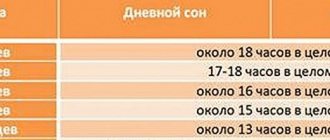It's no secret that there are still persistent myths in our society's knowledge about breastfeeding. Every day, working with breastfeeding mothers in the maternity hospital, I come across common expressions about breastfeeding, which I myself, having 3 years of feeding experience and some education in the field of lactation, at first could not explain. This is what first-time mothers, experienced mothers, grandmothers, some midwives, and sometimes doctors say. These expressions were passed down from generation to generation, and over time their meaning and exact meaning were lost. And today they do not allow a woman to believe in herself, they make the lactation process mysterious and strange, as if beyond the control of the woman herself.
Undeveloped nipples
The first thing we encounter is a mother just after giving birth: “but my nipples are not developed,” “how should nipples be developed?” (Sometimes the expression “developing the breasts” sounds in this sense, although this is usually said about something else.) Women mean preparing the nipples for breastfeeding - the kind recommended by old-school gynecologists: pulling, massaging the nipples, wiping with a terry towel or something similar.
However, today it is known that the nipples are prepared for feeding themselves during pregnancy, and no additional actions are required to “develop” them. It’s just that earlier (and some doctors still) knew nothing about the importance of proper attachment to the breast - the key to painless and non-traumatic sucking.
If the baby suckles correctly from birth, most women do not experience abrasions and there is almost no soreness in the nipples. However, in the maternity hospital, abrasions, cracked nipples and soreness are rather the rule. And not only because they know little about proper breastfeeding - they make many other mistakes. Among them are washing the breast, pulling the nipple out of the baby’s mouth, supplementing with glucose... And most importantly, young mothers allow the baby to take the breast at random and do not control the latch on the breast during the entire sucking.
If you pay a lot of attention to the technique of attachment and feeding in the first days, the child himself will “develop” your nipples. Nothing unnatural. All you need is informational preparation. If you have flat or inverted nipples, then you need to pay even more attention to obtaining information about the correct feeding technique, avoid supplementary feeding of the baby from the nipple and, possibly (especially if you have a cesarean section) wear nipple formers in the last months of pregnancy if there is no threat premature birth. For more information, please contact your lactation consultant.
How can you tell if your breast milk has gone bad?
The main sign is that the smell has changed, it has become sour and unpleasant. Spoiled milk is always easy to recognize by its characteristic rancid smell. To find out for sure, you should taste a drop – the milk is sour and bitter. The type of milk will also indicate to you that it is no longer worth giving it to the child - the whey rises to the top, leaving thick kefir at the bottom. It is worth paying attention to the fact that changes in the color of breast milk are not always a sign of spoilage. Milk that looks bluish may simply lack the necessary fat content; in this case, it is better to change the mother’s diet in order to enrich the baby’s food with the necessary elements.
How to develop breasts?
After the pain goes away, mothers breathe a sigh of relief, saying that “the nipples have developed.” “ Undeveloped ducts ”, “undeveloped breasts”, “how to develop breasts?”. They start talking about this on the 3-4th day, when milk comes in. Classic engorgement occurs - swelling of the mammary gland, congestion occurs in it. The breasts “need to be drained,” the ducts “need to be cleaned” so that the breasts work properly. Sometimes I hear that a husband should dissolve his wife’s ducts before giving birth. But, of course, the chest is not a sewer pipe and does not clog. Hormones during pregnancy prepare the breast tissue for feeding - special cells appear in it that produce milk, additional ducts, and even during pregnancy, many women secrete colostrum. As soon as the placenta has separated from the wall of the uterus, the breast is completely ready to begin the feeding process. The problem of engorgement can be solved by putting the baby to the breast more often, using cool compresses and, if necessary, careful pumping (this is required in no more than 20-40% of cases).
Women giving birth for the second and next time, who have “more developed breasts,” actually simply have more hormone receptors that control the process of milk formation and secretion—the breasts “remember” the situation and work more smoothly. However, simply the experience that the mother had with her first child is very important. And it happens that even with the 3rd or 4th child, a mother encounters pathological engorgement in the maternity hospital.
The expression “develop your breasts” can also mean “increase your milk supply.” “At first there was little milk, but then the breasts developed and there was enough milk.” Most likely, the mother has solved the problems with latching on the breast, and normal stimulation of the mammary gland began to produce milk in the volume the baby needs.
Milk “burns out” due to severe stress
Surely all young mothers have heard that if you are nervous, the milk will disappear. From a scientific point of view, this statement is completely incorrect. Lactation depends on the hormone prolactin, and the nervous system is not associated with it. However, the process of pushing fluid through the ducts occurs thanks to oxytocin. If a woman is nervous, the production of this hormone is hindered, and it is harder for the baby to suck. Therefore, he may refuse to breastfeed, and an inexperienced mother thinks that the milk has “burnt out.”
How to get rid of disturbances in the feeding process during stress:
- take your mind off an annoying situation;
- take a warm bath;
- get a relaxing massage;
- take a walk in the fresh air alone;
- sleep well.
When the mother’s emotional state improves, lactation will quickly recover.
Does it burn out or go sour?
"The milk may burn out." When my baby was about a month old, I was also frightened by this prospect, which sounded like this: “If you don’t express milk after feeding, it will burn out.” Then I was a completely inexperienced mother and called my classmate with a question - she already had a daughter whom she nursed until she was 9 months old. “Well, you know, maybe if you don’t feed for 20 hours, then you’ll burn out,” she answered me.
A couple of years later, I came across an explanation for this phenomenon in the meaning of “burned out” - it burned with fire, with temperature. This is severe mastitis with high fever. Quite often, after suffering from mastitis, milk production is significantly reduced, since the breasts were full for a long time, and signals were sent to the brain that there is no need to produce more milk.
Let's return to the popular expression. There was such a custom in Rus' - after weaning the child, the mother splashed milk from the breast onto the fire so that it would easily go away - “burn out.” Perhaps this is where the expression and concept of “burnt out - lost” came from. Some women understand it this way.
Why milk disappears, I think you've heard. Often “milk disappears due to nerves.” A mother, having given birth to a baby, often worries and worries about various reasons. Stress has no effect on the hormone that stimulates milk production (prolactin), but may temporarily affect the hormone that causes milk to flow from the breast (oxytocin). This temporary cessation of the oxytocion reflex is a useful biological mechanism that stops the flow of milk from the breast during difficult times. Stress has always been a part of human life (wars, natural disasters, epidemics), and if it interfered with breastfeeding, the human race would never have been able to develop. Therefore, if there are no additional factors (improper attachment, rare feedings, lack of night feedings) and the baby sucks well, stress will not be terrible. Unfortunately, loss of milk due to the death of loved ones sometimes happens.
I also heard that milk can “burn out - become bitter” without fever (not as in the case of mastitis), but in between feedings after 3 hours or at night. “But you can’t feed him bitter milk.” But milk cannot spoil in the breast - just like blood in our body. It happens that in case of stagnation or mastitis, the level of sodium salts in milk increases, so the taste of milk becomes salty. The salinity disappears within a week. In case of stagnation, it is not only possible, but also necessary to feed the child, since no one better than the baby will ensure the outflow of milk from the breast, and this is necessary when treating stagnation. But again, we are talking about an abnormal phenomenon, and not about breaks between feedings. “The milk may turn sour, curdled” in the chest.
There are no necessary conditions and components for the souring process in the mammary gland. Milk - both human and cow's - does not turn sour even in the refrigerator for several days.
At what temperature should you store expressed breast milk?
- Room temperature: +23-25 degrees. Breast milk should be stored in a bottle at these temperatures for no more than 4 hours, then the milk should be poured out.
- Refrigerator: a temperature of -4 degrees and below will allow you to store a container of milk for about 4 days. At a temperature of -5-6, milk can be stored for up to 5 days.
- Freezer: It all depends on the type of freezer. It depends on how often you open it, where exactly you store the container of milk, and what the temperature is inside.
- Freezer with a temperature of about -20 degrees – provided that the refrigerator is not self-defrosting: storage for up to six months (6 months).
- Freezer with separate shelf: up to 3 months maximum.
- Cooler bag: depending on how the bag holds the temperature. To play it safe, you should not store milk in such a portable refrigerator for more than one day (24 hours).
- From the freezer on the shelf in the refrigerator, milk will retain its freshness for no more than one day. That is: it is better to put defrosted milk in the refrigerator for several hours, then heat it up and feed the baby.
Got a cold chest
This is the most often cited reason for congestion and mastitis. The cause of mastitis - inflammation of the mammary gland - is the presence of a bacterial infection. Normal hypothermia cannot cause mastitis, but it can provoke a decrease in immunity and reduce resistance to infection. With good outflow of milk, stagnation and mastitis occur very rarely, and most often the cause is a violation of the outflow of milk from any lobule of the mammary gland. Sometimes stress can cause this disorder, blocking the release of oxytocin or the contraction of milk-secreting cells.
Breastfeeding: advice for a young mother
Most women want to breastfeed their baby. And they all have just a huge number of questions about breastfeeding: Do I need to express milk? Should I feed at night? How can you tell if your baby has enough milk? When should you wean? And many others. So, let's try to answer all these questions. How should you put your baby to the breast correctly?
To begin with, you need to lay the baby on his side next to you so that his face touches his chest.
Lift your breast so that the nipple touches the baby's nose - this will trigger the sucking reflex and he will open his mouth. Then insert the nipple and part of the areola into his mouth, holding the breast with your thumb on top and the rest of your fingers on the bottom. You should make sure that the baby has captured not only the nipple, but also the areola with his mouth. If applied correctly, breastfeeding will be painless for the mother. What should you do if your baby bites while feeding?
You need to make sure that the child does not have toys that resemble a pacifier (pacifiers, bottles with a hard spout).
Sometimes it happens that the baby bites the breast at the end of breastfeeding. This is due to the fact that he relaxes and does not control his actions. Therefore, you need to remove the nipple from the baby’s mouth before he relaxes after nourishing milk. What to do if cracked nipples appear?
If deep cracks appear, then it is necessary to stop breastfeeding for a while (7-10 days), and feed the baby with expressed milk.
Nipples need to be lubricated with a special cream, for example Bepanten, after each expression of milk. After they heal, it is necessary to establish the correct attachment of the baby to the breast, since cracks in the nipples arose due to improper attachment. How to feed expressed milk?
Expressed milk should be given using a spoon or a syringe without a needle, but not from a bottle, as the baby may get used to it and refuse the breast, or due to easy sucking from the bottle, he may lose the habit of proper sucking, thereby injuring the nipple mother, grabbing it with her gums, and not with her lips and tongue.
Should only one breast be offered during feeding?
If the baby suckled at the breast for about 5 minutes and fell asleep, then at the next feeding you can give it again.
In this case, the time between feedings should not exceed 1-1.5 hours. If he suckled for more than 15 minutes, then at the next feeding you need to give the other breast. How many times a day should you feed your baby?
Many pediatricians recommend breastfeeding on demand, that is, it is necessary to put the baby to the breast when he asks.
How to get an equal amount of milk in both breasts?
You should make a schedule, for example, feed the baby with the right breast from 9 to 11, and with the left from 11 to 13, and so on throughout the day.
Why does it happen that there is more milk in one breast than in the other?
This phenomenon often happens when one breast becomes a child’s favorite because it is easier to get milk from it.
This is explained by the fact that in the location and structure of all paired human organs there are subtle disproportions, for example, one eye is located slightly higher than the other or sees better than the other. Should I express any remaining milk after feeding?
Previously, this was done when children were fed by the hour, after 3-3.5 hours.
Due to such infrequent feeding, many women experienced stagnation of milk, so they had to express it. If you feed your baby on demand, then there is no need to express the leftovers. What is hyperlactation?
Hyperlactation occurs when breastfeeding a child occurs on demand, and at the same time, the woman expresses the remaining milk after feeding.
Because of this, more milk is produced than the baby can eat. Why does the milk come out watery first and then thick?
This is how nature made sure that the baby sucks breast milk with pleasure.
Foremilk is liquid and sweet, which the baby sucks easily and with pleasure, and by the end of feeding he receives healthy hindmilk - fatty, thick, yellowish in color. Therefore, in order for the baby to receive not only foremilk, but also hindmilk, it is necessary to feed him from one breast for at least 15 minutes. What to do if a child chokes while feeding?
If the baby does not have time to swallow the milk due to the strong flow, he begins to choke, in this case, you should wean him from the breast and hold him in a column, let him rest a little, and then continue feeding.
The following position will help reduce the flow of milk: lying on your back, put the baby on your chest and feed in this position. What to do if the baby does not want to breastfeed?
This problem usually occurs because he has been introduced to a bottle or pacifier, so he needs to give it up and only breastfeed when he is half asleep.
Breastfeeding will soon improve. If a child refuses to breastfeed and does not know what a bottle or pacifier is, then you need to check his nose (it may be clogged) and mouth (due to inflamed gums, during teething). Why do you need to feed at night?
At night, the female body determines how much milk it needs the next day.
Therefore, if you do not feed at night, it may affect lactation. How to maintain breastfeeding if mom goes to work?
At work, mothers need to express milk every 3 hours.
Place the expressed milk in special plastic sealed containers and place in the refrigerator. Before feeding, the milk should be heated in a water bath to a temperature of 36 degrees. What should you do if milk leaks from the other when you are breastfeeding?
This phenomenon is absolutely normal.
Just during feeding you need to put a special pad in your bra that will absorb the milk. How can you tell if you have enough milk?
You can check whether you have enough milk like this: in a week the baby should gain 110-125 grams.
You can also do a wet diaper test: you need to give up diapers for a day and count how many wet diapers there are. If the baby pees 12 times a day, it means he has enough milk. How much fluid should a nursing mother drink?
You should not drink forcefully.
It is enough to drink every time you are thirsty. The liquid can be: plain water, compote, green and black tea, fermented milk drinks. How to prevent milk stagnation (lactostasis)?
A sharp increase in the amount of milk should not be allowed, so in the first weeks of feeding after childbirth you need to limit fluid intake to 1000 ml per day.
You also need to put your baby to your breast more often. If stagnation of milk does occur, then you need to express it a little before feeding, otherwise the baby will not be able to latch onto the tense nipple. In addition, it is important to massage the mammary glands and ensure that painful and dense areas do not appear on them. Can milk burn out at high body temperature?
No, he can not.
At high temperatures, milk production may simply decrease. Is it possible to breastfeed if mom is sick?
It is not possible to feed during illness, but it is necessary, because human milk produces antibodies that support the health of the baby.
In this case, you need to tell your doctor that you are breastfeeding so that he can prescribe the appropriate medications. When to introduce complementary foods while breastfeeding?
Introducing complementary foods should begin no earlier than the baby’s six months, because his digestive system is not yet able to digest food other than breast milk.
Do I need to give my baby extra water?
A baby who is breastfed until six months of age does not need to be supplemented with water.
Breast milk is 80% water. Is it possible to breastfeed if the mother is pregnant again?
During a new pregnancy, you can breastfeed your first child if the mother feels well and there is no threat of termination of pregnancy.
Is it possible to continue breastfeeding my first child after the birth of my youngest?
It is possible if a woman eats well, takes vitamin supplements and rests.
How to properly start weaning from breastfeeding?
In order for weaning from breastfeeding to be smooth for both mother and baby, weaning must be done gradually.
First, you should remove intermediate feedings and make sure that he can easily do without them. Then we remove feeding before naptime. In this case, you will need helpers, let dad or grandmother put the baby to bed during the weaning period. Also, then you should remove feeding before bedtime and put the baby to bed. The last stage is to eliminate night feedings; instead of breastfeeding, you can offer the baby compote or milk from a cup. When should you wean?
Experts from the World Health Organization are of the opinion that weaning should be no earlier than 2.5 years.
You need to feed at least until 1-1.5 years. What to do with lactation during weaning?
The process of completing breastfeeding is gradual, so it is necessary for the body to complete lactation on its own without using any medications.
What to do if milk is still released after stopping feeding?
After stopping breastfeeding, six months to a year later, if you press on the areola near the nipple, a few drops of milk may come out. This is normal. There is no need to express it; it will fade away on its own after some time.
I have weak nipples
This happens, the woman says, meaning that milk leaks from the breast not only during feeding, but also between feedings: when she just thinks about her baby, or presses her breast while sleeping, or when the baby starts crying, asking for the breast. . Galactorrhea (milk leakage) indicates a well-developed milk ejection reflex, because in the first months after childbirth, a nursing woman has a fairly high level of oxytocin. So this is not a reason for grief, but rather the opposite.
You can stop the release of milk by lightly pressing the nipple with your fingers (as if “pressing a bell”) or crossing your arms over your chest and pressing them towards you. It has been noticed that milk flows less often from breasts raised by a bra than from breasts lowered. If milk leaks a lot, you can wear special milk collection pads or simply absorbent ones. The latter should be changed more often, as wet skin loosens and becomes more sensitive to cracks and inflammation. When lactation is established, most likely, milk leakage will stop bothering you.
The concept of "burnt milk"
In ancient times, women who wanted to stop breastfeeding had a certain ritual. They expressed the remaining milk onto the hot stove. It was believed that as soon as the last drops evaporated, that is, burned out, lactation would stop by itself.
Of course, the custom has long been forgotten, but the phrase “burnt milk” remains. Only the meaning behind it is different. Here are common myths about how breast milk burns out:
- disappears due to mother's illness;
- disappears from severe stress;
- sour due to infrequent feeding of the baby.
See also:
- Can a woman breastfeed after breast augmentation?
- Mastitis
- Preparing for breastfeeding
- Composition of breast milk
- Nutrition for a nursing mother
Taste and color...
“My milk is blue, it’s not good.” A woman's milk is as different from a cow's milk as a woman herself is different from a cow. Colostrum is most often yellow or yellowish-orange and is more concentrated and contains more protein and fat. The process of transition of colostrum into “mature” milk can last about two weeks. During this period, the color of the milk gradually changes and becomes bluish-white. What kind of “blue milk” does mom mean? The fact is that milk has different composition during feeding. At the beginning of feeding, “foremilk” is released, which is rich in water and carbohydrates. It’s just that it seems completely transparent to mom. At the end of feeding, “hind” milk, rich in fats, comes. You can try expressing a few drops after feeding to see how different it is from the "fore" milk.
“I have low-fat milk, what should I eat?” There is, of course, the proverb “Milk is on the cow’s tongue,” but does it make sense to increase the fat content of a woman’s milk? Nature has made mother's milk the ideal nutrition for a baby, and it is enough for a mother to simply eat a nutritious and balanced diet. Do not go on strict diets, do not specifically rely on any type of food to change the composition of your milk, exclude “harmful” foods (rich in artificial fillers, preservatives, dyes, etc.) - then your baby will receive everything from your milk necessary.
Breast milk: proper storage
First: to store breast milk, you should choose the right dishes, a thermos bag. It is better to purchase bottles for breast milk in pharmacies, it is more reliable, so you can be completely sure that the dishes have passed all the tests, they are hermetically packaged, and of high quality. Avent products have proven themselves well .
There are several types of containers:
- Glassware. Better for storage, but with sudden temperature changes it can be damaged. If you put it in hot water immediately after the freezer, damage and cracks may occur.
- Plastic dishes. Slightly inferior to glassware in storage, but more practical, resistant to temperature changes.
Important
: bottles should hold from 80 to 120 grams of milk - everything is individual, since your baby will not be able to eat more at one time. If you constantly open and close, heat and pour milk, it will spoil faster. This way you will be sure that the rest of the milk is safe and sound. Don't forget to label your breast milk containers so you know exactly when it was expressed.
When is it necessary to express breast milk?
There are not many such situations, but it is in these cases that it becomes a necessity.
| Premature baby | Babies born prematurely do not yet know how to breastfeed because they lack the sucking reflex. But they are able to absorb mother’s milk, moreover, they, like no one else, vitally need natural nutrition, saturated with all the necessary substances that accelerate ripening and growth. |
| Poorly developed sucking reflex, various pathologies in a child | In medicine, there is such a thing as a “lazy sucker.” A weak sucking reflex is due to various reasons, including pathologies of the central nervous system. However, this is not a reason to stop lactation; milk can be expressed and offered to the baby in an easier way - through a bottle. |
| Lactation deficiency | Is it possible to express milk when the quantity is already small? The recommendation that milk production is increased by expressing is still not universal. Pumping and natural breastfeeding are two different things, and feeding has a much stronger effect on the process of milk retention. But in the fight for lactation, all means are good: you should express your breasts next to the baby and with thoughts about him, as this promotes milk production. |
| Formation of lactation (milk supply) | The first milk that is produced after childbirth is not such. This colostrum is a thicker and richer substance, very filling and healthy. There is not much of it, but the child is satisfied in a couple of sips. On the 2-3rd day milk comes, and in such a volume that it is impossible for a still weak baby to cope. Swollen and heavy breasts need to be released, because not drinking milk is a signal for a decrease in its production. In order for milk to be produced at the same pace, and for an already strong baby to have enough of it, you need to pump, but not to the last drop, but until the breasts become lighter and softer. |
| Milk stagnation is a condition that threatens the development of mastitis | Such a disaster happens when the breast is sucked incorrectly, when the baby’s sucking reflex is weak, and also when pumping incorrectly! In this case, it is targeted, from hardened slices. |
| Taking medications that are excreted in breast milk | Very few drugs of synthetic and herbal origin are allowed during breastfeeding. In situations where, for health reasons, a nursing mother is forced to take certain medications, she needs to express herself and pour the expressed milk down the drain - this is the only way to maintain lactation. Of course, this is not very good for lactation and for the baby, since he will have to eat formula. Alternatively, if the mother knows that she will be taking medications soon, she can store milk for future use, which we will discuss below. |
| Flat, inverted nipple | The reason is somewhat arbitrary, since there are special covers that are placed on the nipple and make breastfeeding easier. If all else fails, you need to pump your breasts and bottle-feed your baby. |
| Separation from a child | If the mother needs to go somewhere, or she works, pumping is indispensable if breastfeeding is a priority. The same situation arises if the baby is undergoing treatment, but without a mother - the milk can be expressed and transferred to the staff for feeding. |
| Preparing breast milk for future use | The desire to preserve breast milk for as long as possible is the reason that many mothers simultaneously feed the child and store milk for the future. But this makes sense when the mother plans to stop breastfeeding soon, but does not want to deprive the child of a valuable product. During storage, mother's milk still somewhat loses its beneficial properties, and storage also has its own strict deadlines. |









